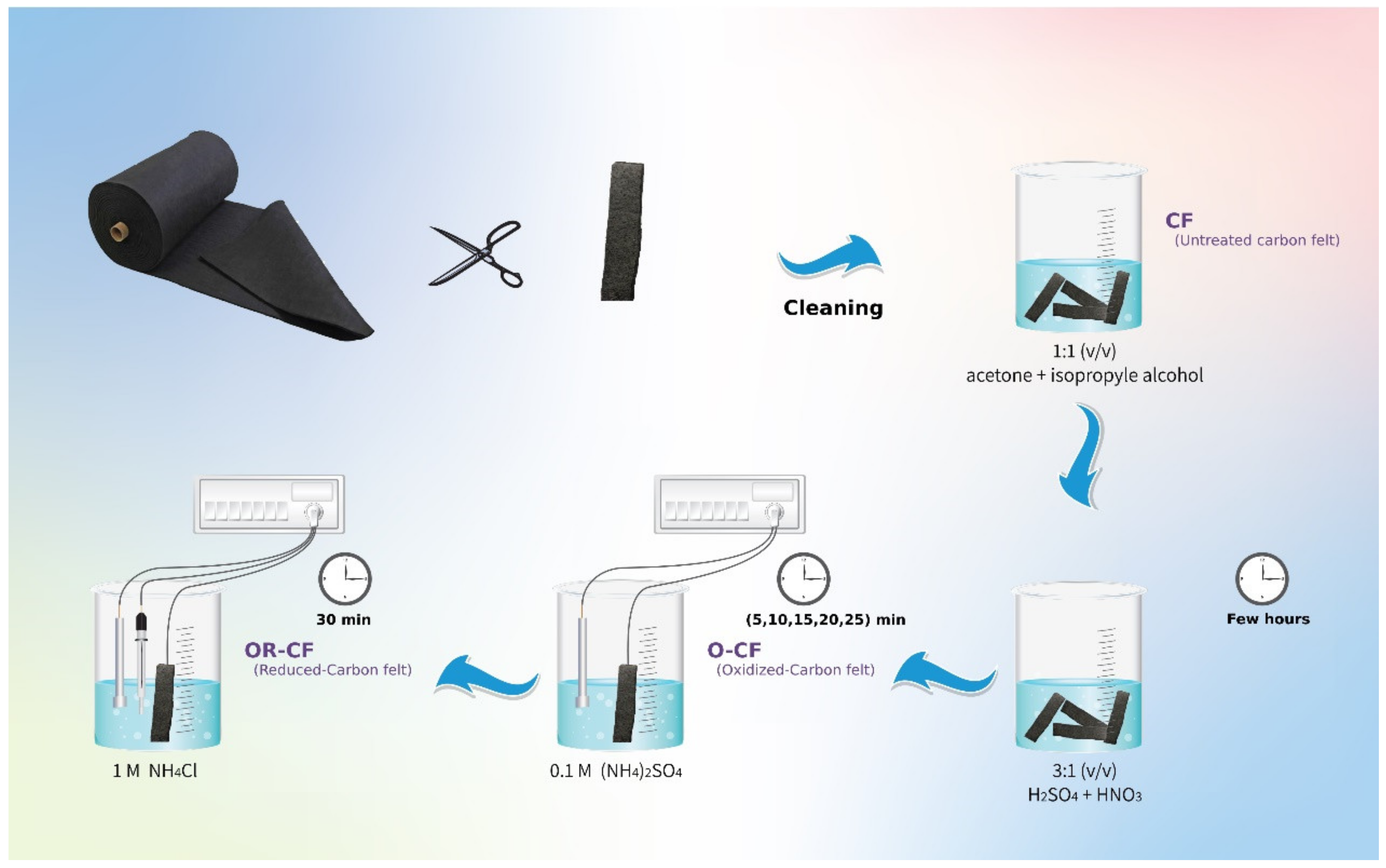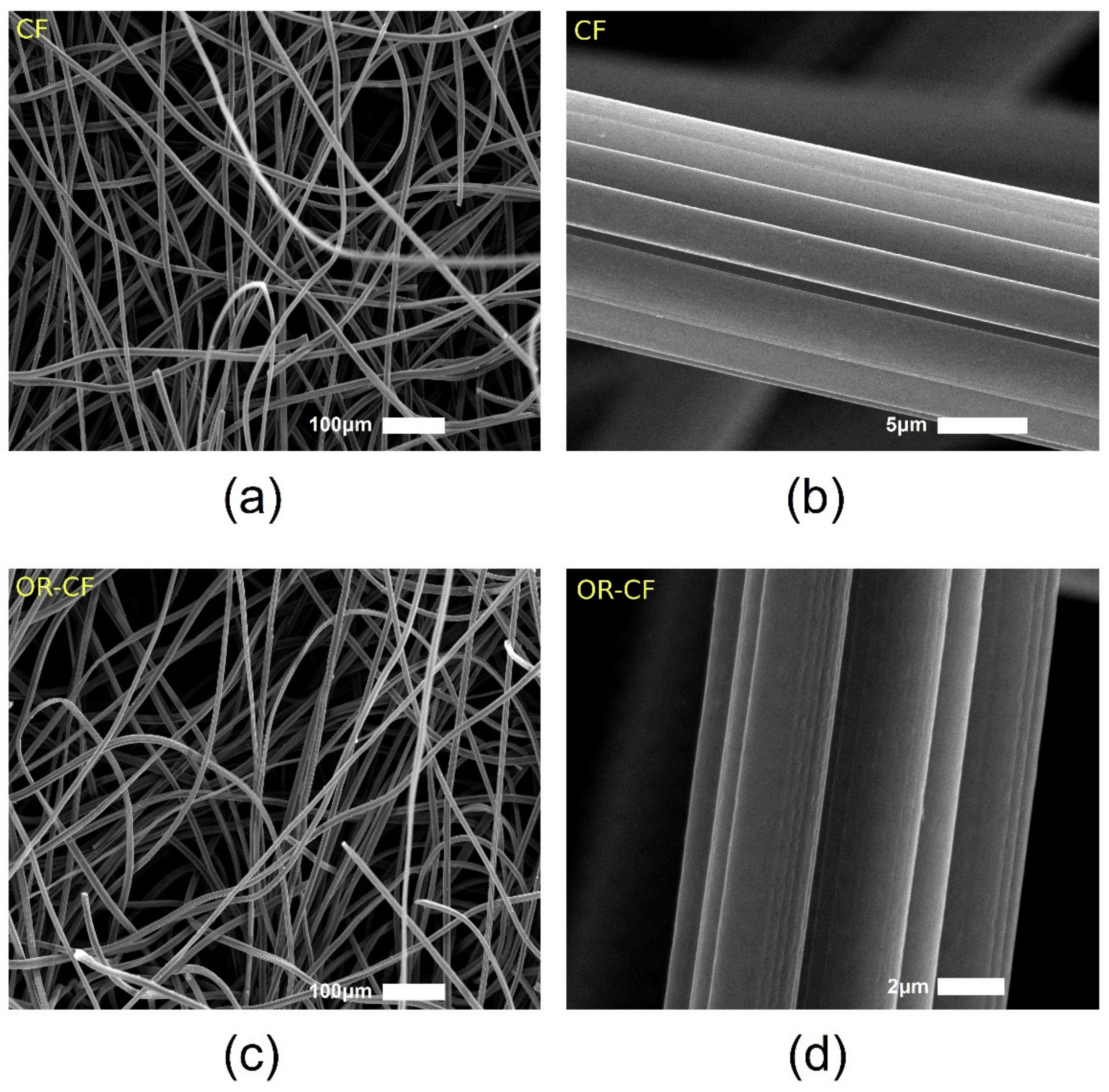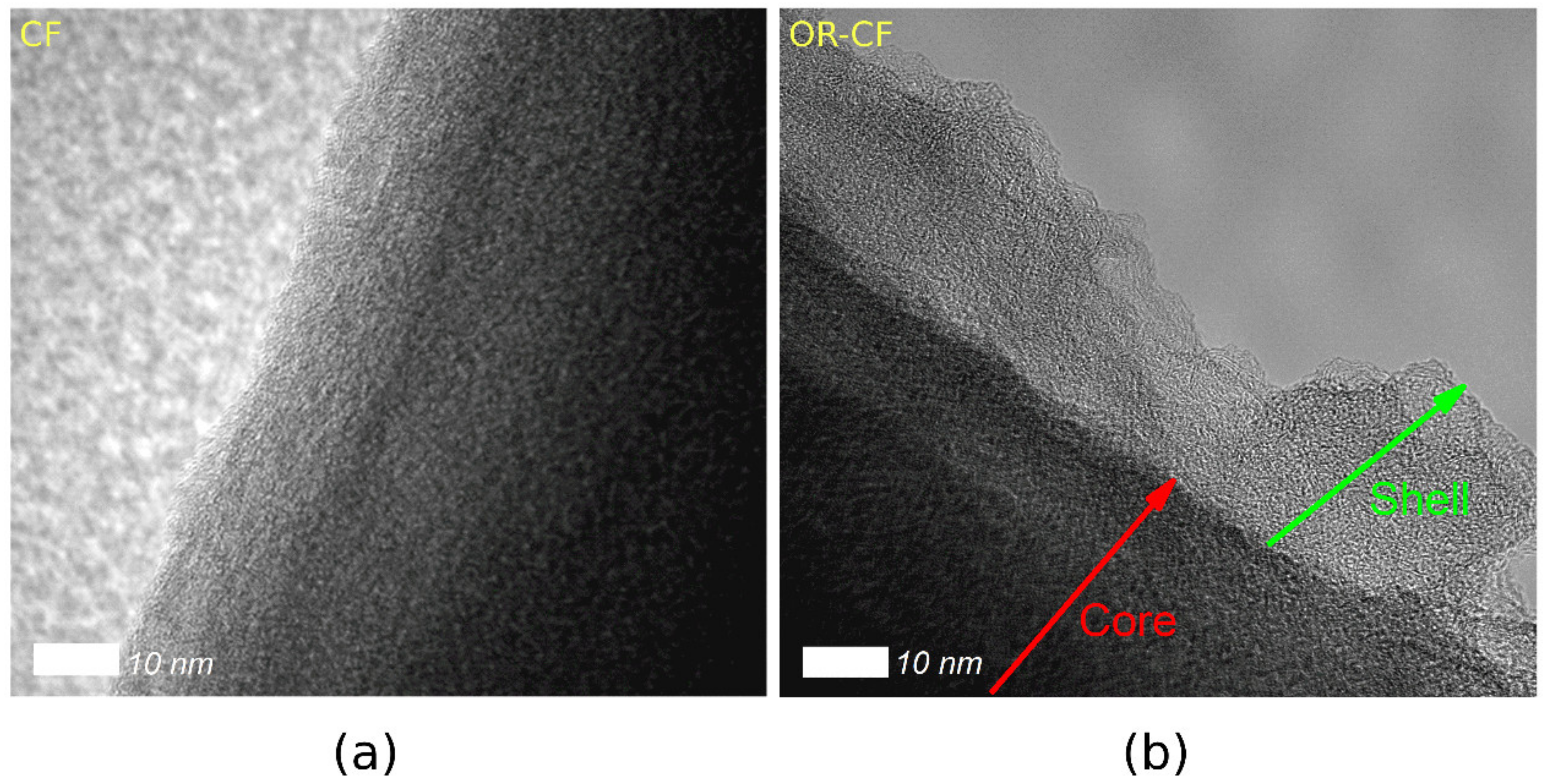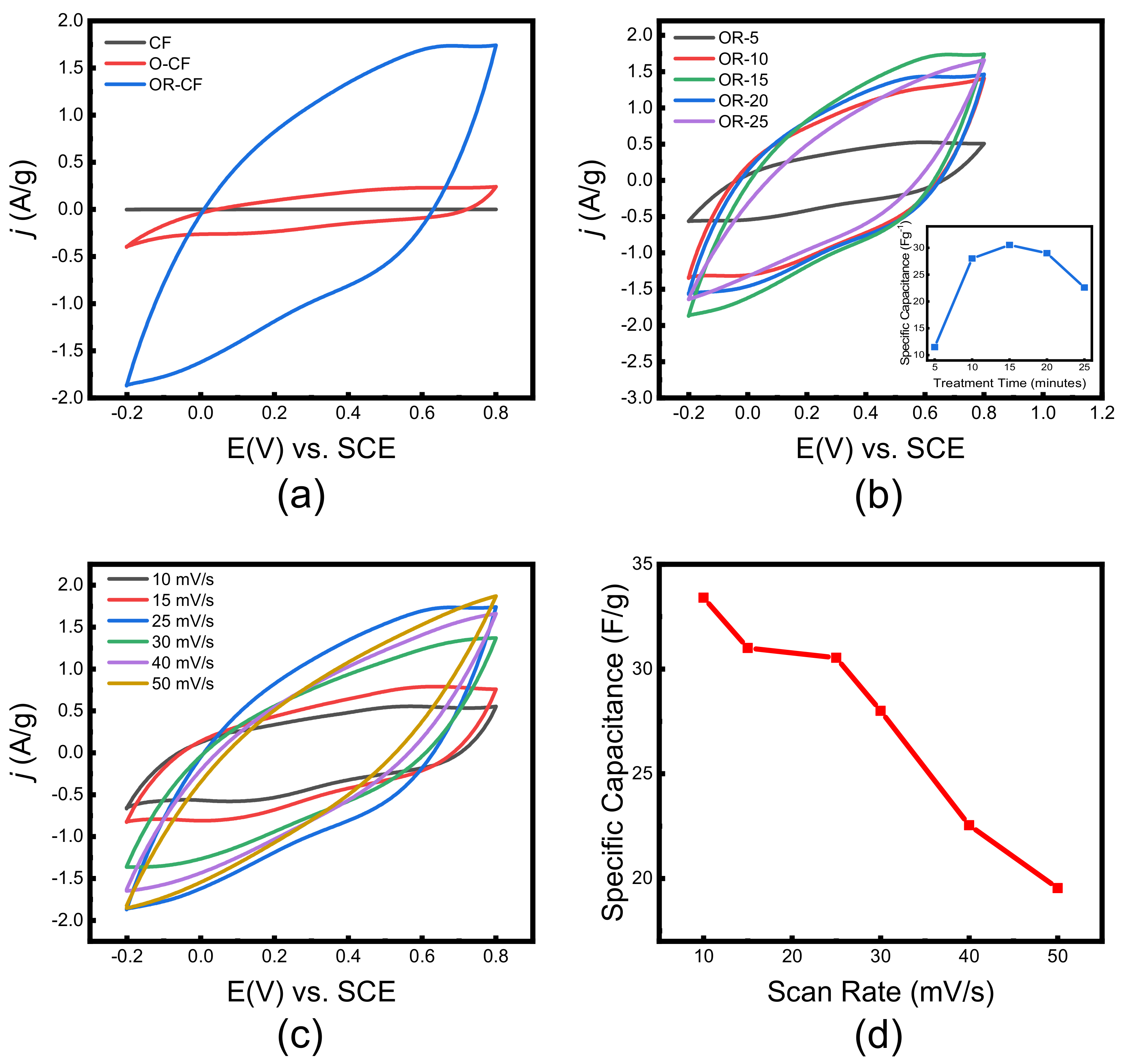Enhancing the Performance of a Metal-Free Self-Supported Carbon Felt-Based Supercapacitor with Facile Two-Step Electrochemical Activation
Abstract
:1. Introduction
2. Materials and Methods
2.1. Sample Preparation
2.2. Sample Characterization
2.3. Calculations
3. Results and Discussion
4. Conclusions
Supplementary Materials
Author Contributions
Funding
Data Availability Statement
Acknowledgments
Conflicts of Interest
References
- Dunya, H.; Ashuri, M.; Alramahi, D.; Yue, Z.; Kucuk, K.; Segre, C.U.; Mandal, B.K. MnO2-Coated Dual Core–Shell Spindle-Like Nanorods for Improved Capacity Retention of Lithium–Sulfur Batteries. ChemEngineering 2020, 4, 42. [Google Scholar] [CrossRef]
- Yue, Z.; Dunya, H.; Ashuri, M.; Kucuk, K.; Aryal, S.; Antonov, S.; Mandal, B.K. Synthesis of a very high specific surface area active carbon and its electrical double-layer capacitor properties in organic electrolytes. ChemEngineering 2020, 4, 43. [Google Scholar] [CrossRef]
- González, A.; Goikolea, E.; Barrena, J.A.; Mysyk, R. Review on Supercapacitors: Technologies and Materials. Renew. Sustain. Energy Rev. 2016, 58, 1189–1206. [Google Scholar] [CrossRef]
- Zhang, L.; Zhao, X.S. Carbon-Based Materials as Supercapacitor Electrodes. Chem. Soc. Rev. 2009, 38, 2520–2531. [Google Scholar] [CrossRef] [PubMed]
- Miller, J.M.; Dunn, B.; Tran, T.D.; Pekala, R.W. Deposition of Ruthenium Nanoparticles on Carbon Aerogels for High Energy Density Supercapacitor Electrodes. J. Electrochem. Soc. 1997, 144, L309–L311. [Google Scholar] [CrossRef]
- Frackowiak, E.; Béguin, F. Carbon Materials for the Electrochemical Storage of Energy in Capacitors. Carbon 2001, 39, 937–950. [Google Scholar] [CrossRef]
- Pech, D.; Brunet, M.; Durou, H.; Huang, P.; Mochalin, V.; Gogotsi, Y.; Taberna, P.L.; Simon, P. Ultrahigh-Power Micrometre-Sized Supercapacitors Based on Onion-like Carbon. Nat. Nanotechnol. 2010, 5, 651–654. [Google Scholar] [CrossRef]
- Hu, L.; Hecht, D.S.; Grüner, G. Carbon Nanotube Thin Films: Fabrication, Properties, and Applications. Chem. Rev. 2010, 110, 5790–5844. [Google Scholar] [CrossRef]
- Yu, D.; Goh, K.; Wang, H.; Wei, L.; Jiang, W.; Zhang, Q.; Dai, L.; Chen, Y. Scalable Synthesis of Hierarchically Structured Carbon Nanotube-Graphene Fibres for Capacitive Energy Storage. Nat. Nanotechnol. 2014, 9, 555–562. [Google Scholar] [CrossRef]
- Béguin, F.; Presser, V.; Balducci, A.; Frackowiak, E. Carbons and Electrolytes for Advanced Supercapacitors. Adv. Mater. 2014, 26, 2219–2251. [Google Scholar] [CrossRef]
- Stoller, M.D.; Park, S.; Zhu, Y.; An, J.; Ruoff, R.S. Graphene-Based Ultracapacitors. Nano Lett. 2008, 8, 3498–3502. [Google Scholar] [CrossRef] [PubMed]
- Qu, D.; Shi, H. Studies of Activated Carbons Used in Double-Layer Capacitors. J. Power Sources 1998, 74, 99–107. [Google Scholar] [CrossRef]
- Merlet, C.; Rotenberg, B.; Madden, P.A.; Taberna, P.L.; Simon, P.; Gogotsi, Y.; Salanne, M. On the Molecular Origin of Supercapacitance in Nanoporous Carbon Electrodes. Nat. Mater. 2012, 11, 306–310. [Google Scholar] [CrossRef] [PubMed] [Green Version]
- Cheng, Q.; Tang, J.; Ma, J.; Zhang, H.; Shinya, N.; Qin, L.C. Polyaniline-Coated Electro-Etched Carbon Fiber Cloth Electrodes for Supercapacitors. J. Phys. Chem. C 2011, 115, 23584–23590. [Google Scholar] [CrossRef]
- Zhang, T.; Kim, C.H.J.; Cheng, Y.; Ma, Y.; Zhang, H.; Liu, J. Making a Commercial Carbon Fiber Cloth Having Comparable Capacitances to Carbon Nanotubes and Graphene in Supercapacitors through a “Top-down” Approach. Nanoscale 2015, 7, 3285–3291. [Google Scholar] [CrossRef]
- Kaempgen, M.; Chan, C.K.; Ma, J.; Cui, Y.; Gruner, G. Printable Thin Film Supercapacitors Using Single-Walled Carbon Nanotubes. Nano Lett. 2009, 9, 1872–1876. [Google Scholar] [CrossRef]
- Lu, X.; Zhai, T.; Zhang, X.; Shen, Y.; Yuan, L.; Hu, B.; Gong, L.; Chen, J.; Gao, Y.; Zhou, J.; et al. WO3−x@Au@MnO2 Core-Shell Nanowires on Carbon Fabric for High-Performance Flexible Supercapacitors. Adv. Mater. 2012, 24, 938–944. [Google Scholar] [CrossRef]
- Yuan, L.; Xiao, X.; Ding, T.; Zhong, J.; Zhang, X.; Shen, Y.; Hu, B.; Huang, Y.; Zhou, J.; Wang, Z.L. Paper-Based Supercapacitors for Self-Powered Nanosystems. Angew. Chem. 2012, 124, 5018–5022. [Google Scholar] [CrossRef]
- Xu, Y.; Lin, Z.; Huang, X.; Liu, Y.; Huang, Y.; Duan, X. Flexible Solid-State Supercapacitors Based on Three-Dimensional Graphene Hydrogel Films. ACS Nano 2013, 7, 4042–4049. [Google Scholar] [CrossRef]
- Lou, G.; Wu, Y.; Zhu, X.; Lu, Y.; Yu, S.; Yang, C.; Chen, H.; Guan, C.; Li, L.; Shen, Z. Facile Activation of Commercial Carbon Felt as a Low-Cost Free-Standing Electrode for Flexible Supercapacitors. ACS Appl. Mater. Interfaces 2018, 10, 42503–42512. [Google Scholar] [CrossRef]
- Zhang, L.L.; Zhou, R.; Zhao, X.S. Graphene-Based Materials as Supercapacitor Electrodes. J. Mater. Chem. 2010, 20, 5983–5992. [Google Scholar] [CrossRef]
- Le, T.X.H.; Bechelany, M.; Cretin, M. Carbon Felt Based-Electrodes for Energy and Environmental Applications: A Review. Carbon 2017, 122, 564–591. [Google Scholar] [CrossRef]
- Wang, G.; Wang, H.; Lu, X.; Ling, Y.; Yu, M.; Zhai, T.; Tong, Y.; Li, Y. Solid-State Supercapacitor Based on Activated Carbon Cloths Exhibits Excellent Rate Capability. Adv. Mater. 2014, 26, 2676–2682. [Google Scholar] [CrossRef] [PubMed]
- Raymundo-Piñero, E.; Cadek, M.; Béguin, F. Tuning Carbon Materials for Supercapacitors by Direct Pyrolysis of Seaweeds. Adv. Funct. Mater. 2009, 19, 1032–1039. [Google Scholar] [CrossRef]
- Su, F.; Poh, C.K.; Chen, J.S.; Xu, G.; Wang, D.; Li, Q.; Lin, J.; Lou, X.W. Nitrogen-Containing Microporous Carbon Nanospheres with Improved Capacitive Properties. Energy Environ. Sci. 2011, 4, 717–724. [Google Scholar] [CrossRef]
- Hulicova-Jurcakova, D.; Seredych, M.; Lu, G.Q.; Bandosz, T.J. Combined Effect of Nitrogen- and Oxygen-Containing Functional Groups of Microporous Activated Carbon on Its Electrochemical Performance in Supercapacitors. Adv. Funct. Mater. 2009, 19, 438–447. [Google Scholar] [CrossRef]
- Fang, B.; Bonakdarpour, A.; Kim, M.S.; Kim, J.H.; Wilkinson, D.P.; Yu, J.S. Multimodal Porous Carbon as a Highly Efficient Electrode Material in an Electric Double Layer Capacitor. Microporous Mesoporous Mater. 2013, 182, 1–7. [Google Scholar] [CrossRef]
- Fang, B.; Binder, L. Enhanced Surface Hydrophobisation for Improved Performance of Carbon Aerogel Electrochemical Capacitor. Electrochim. Acta 2007, 52, 6916–6921. [Google Scholar] [CrossRef]
- Cao, H.; Peng, X.; Zhao, M.; Liu, P.; Xu, B.; Guo, J. Oxygen Functional Groups Improve the Energy Storage Performances of Graphene Electrochemical Supercapacitors. RSC Adv. 2018, 8, 2858–2865. [Google Scholar] [CrossRef] [Green Version]
- Miao, Z.; Huang, Y.; Xin, J.; Su, X.; Sang, Y.; Liu, H.; Wang, J.-J. High-Performance Symmetric Supercapacitor Constructed Using Carbon Cloth Boosted by Engineering Oxygen-Containing Functional Groups. ACS Appl. Mater. Interfaces 2019, 11, 18044–18050. [Google Scholar] [CrossRef]
- Deng, W.; Ji, X.; Gömez-Mingot, M.; Lu, F.; Chen, Q.; Banks, C.E. Graphene Electrochemical Supercapacitors: The Influence of Oxygen Functional Groups. Chem. Commun. 2012, 48, 2770–2772. [Google Scholar] [CrossRef] [PubMed]
- Zhang, S.; Pan, N. Supercapacitors Performance Evaluation. Adv. Energy Mater. 2015, 5, 1–19. [Google Scholar] [CrossRef] [Green Version]
- Zhang, G.; Sun, S.; Yang, D.; Dodelet, J.P.; Sacher, E. The Surface Analytical Characterization of Carbon Fibers Functionalized by H2SO4/HNO3 Treatment. Carbon 2008, 46, 196–205. [Google Scholar] [CrossRef]
- Hidalgo, D.; Tommasi, T.; Bocchini, S.; Chiolerio, A.; Chiodoni, A.; Mazzarino, I.; Ruggeri, B. Surface Modification of Commercial Carbon Felt Used as Anode for Microbial Fuel Cells. Energy 2016, 99, 193–201. [Google Scholar] [CrossRef]
- Eifert, L.; Banerjee, R.; Jusys, Z.; Zeis, R. Characterization of Carbon Felt Electrodes for Vanadium Redox Flow Batteries: Impact of Treatment Methods. J. Electrochem. Soc. 2018, 165, A2577–A2586. [Google Scholar] [CrossRef] [Green Version]
- Ye, D.; Yu, Y.; Tang, J.; Liu, L.; Wu, Y. Electrochemical Activation of Carbon Cloth in Aqueous Inorganic Salt Solution for Superior Capacitive Performance. Nanoscale 2016, 8, 10406–10414. [Google Scholar] [CrossRef]
- Jiang, S.; Shi, T.; Zhan, X.; Long, H.; Xi, S.; Hu, H.; Tang, Z. High-Performance All-Solid-State Flexible Supercapacitors Based on Two-Step Activated Carbon Cloth. J. Power Sources 2014, 272, 16–23. [Google Scholar] [CrossRef]
- Li, X.G.; Huang, K.L.; Liu, S.Q.; Ning, T.A.N.; Chen, L.Q. Characteristics of Graphite Felt Electrode Electrochemically Oxidized for Vanadium Redox Battery Application. Trans. Nonferrous Met. Soc. China 2007, 17, 195–199. [Google Scholar] [CrossRef]
- Palchoudhury, S.; Ramasamy, K.; Gupta, R.K.; Gupta, A. Flexible Supercapacitors: A Materials Perspective. Front. Mater. 2019, 5, 1–9. [Google Scholar] [CrossRef] [Green Version]
- Xie, S.; Liu, S.; Cheng, P.F.; Lu, X. Recent Advances toward Achieving High-Performance Carbon-Fiber Materials for Supercapacitors. ChemElectroChem 2018, 5, 571–582. [Google Scholar] [CrossRef]
- Hontoria-Lucas, C.; López-Peinado, A.J.; López-González, J.D.D.; Rojas-Cervantes, M.L.; Martín-Aranda, R.M. Study of Oxygen-Containing Groups in a Series of Graphite Oxides: Physical and Chemical Characterization. Carbon 1995, 33, 1585–1592. [Google Scholar] [CrossRef]
- Sahoo, N.G.; Rana, S.; Cho, J.W.; Li, L.; Chan, S.H. Polymer Nanocomposites Based on Functionalized Carbon Nanotubes. Prog. Polym. Sci. 2010, 35, 837–867. [Google Scholar] [CrossRef]
- Moreno-Castilla, C.; López-Ramón, M.V.; Carrasco-Marín, F. Changes in Surface Chemistry of Activated Carbons by Wet Oxidation. Carbon 2000, 38, 1995–2001. [Google Scholar] [CrossRef]
- Biniak, S.; Szymański, G.; Siedlewski, J.; Światkoski, A. The Characterization of Activated Carbons with Oxygen and Nitrogen Surface Groups. Carbon 1997, 35, 1799–1810. [Google Scholar] [CrossRef]
- Pandolfo, A.G.; Hollenkamp, A.F. Carbon Properties and Their Role in Supercapacitors. J. Power Sources 2006, 157, 11–27. [Google Scholar] [CrossRef]
- Rodrigues, A.C.; Munhoz, M.G.C.; Pinheiro, B.S.; Batista, A.F.; Amaral-Labat, G.A.; Cuña, A.; Matsushima, J.T.; Marcuzzo, J.S.; Baldan, M.R. N-Activated Carbon Fiber Produced by Oxidation Process Design and Its Application as Supercapacitor Electrode. J. Porous Mater. 2020, 27, 141–149. [Google Scholar] [CrossRef]
- Tian, M.; Wu, J.; Li, R.; Chen, Y.; Long, D. Fabricating a high-energy-density supercapacitor with asymmetric aqueous redox additive electrolytes and free-standing activated-carbon-felt electrodes. Chem. Eng. J. 2019, 363, 183–191. [Google Scholar] [CrossRef]
- Pina, A.C.; Amaya, A.; Marcuzzo, J.S.; Rodrigues, A.C.; Baldan, M.R.; Tancredi, N.; Cuña, A. Supercapacitor electrode based on activated carbon wool felt. J. Carbon Res. 2018, 4, 24. [Google Scholar] [CrossRef] [Green Version]
- Chen, L.; Wu, C.; Qin, W.; Wang, X.; Jia, C. Enhanced electrochemical behaviors of carbon felt electrode using redox-active electrolyte for all-solid-state supercapacitors. J. Colloid Interface Sci. 2020, 577, 12–18. [Google Scholar] [CrossRef]
- Gu, Y.J.; Wen, W.; Wu, J.M. Simple air calcination affords commercial carbon cloth with high areal specific capacitance for symmetrical supercapacitors. J. Mater. Chem. A 2018, 6, 21078–21086. [Google Scholar] [CrossRef]
- Wang, Q.; Ren, W.; Gao, F.; Qiu, C.; Wang, Q.; Gao, F.; Zhao, C. Thermally activated multilayered carbon cloth as flexible supercapacitor electrode material with significantly enhanced areal energy density. ChemElectroChem 2019, 6, 1768–1775. [Google Scholar] [CrossRef]
- Chodankar, N.R.; Ji, S.H.; Kim, D.H. Surface modified carbon cloth via nitrogen plasma for supercapacitor applications. J. Electrochem. Soc. 2018, 165, A2446. [Google Scholar] [CrossRef]
- Hérou, S.; Crespo Ribadeneyra, M.; Schlee, P.; Luo, H.; Tanase, L.C.; Roβberg, C.; Titirici, M. The Impact of Having an Oxygen-Rich Microporous Surface in Carbon Electrodes for High-Power Aqueous Supercapacitors. J. Energy Chem. 2020, 53, 36–48. [Google Scholar] [CrossRef]
- Schalenbach, M. Impedance Spectroscopy and Cyclic Voltammetry to Determine Double Layer Capacitances and Electrochemically Active Surface Areas. ECSarXiv 2018. [Google Scholar] [CrossRef]






| Materials | Activation Method | Electrolyte | Cell Configuration | Capacitance Fg−1 (or as Stated) | Charging Current Density mAg−1 (or as Stated) | Surface Area (m2 g−1) | Ref. |
|---|---|---|---|---|---|---|---|
| Carbon Felt | Chemical | 1 M H2SO4 | 3-electrode | 205 | 23 | --- | Present study |
| Freeze drying | 1 M H2SO4 | 3-electrode | 280 | 0.5 mA cm−2 | 2109 | [20] | |
| Thermal | 2 M H2SO4 | 3-electrode | 213 | 2 Ag−1 | 177 | [46] | |
| Thermal | 2 M KOH | 2-electrode | 120 | CV | 1196 | [47] | |
| Thermal | 2 M KOH | 3-electrode | 163 | 20 | 1140 | [48] | |
| Thermal | VOSO4 and H2SO4 | Cell | 234 mFcm−2 | 2 mA cm−2 | --- | [49] | |
| Carbon Cloth | Chemical | 1 M H2SO4 | 3-electrode | 8.8 mFg−1 | 20 mA cm−2 | 61.2 | [23] |
| PVA/H2SO4 | 2-electrode | 1.55 mFg−1 | |||||
| Polymerization | 1 M H2SO4 | 3-electrode | 42 | 6 mA cm−2 | --- | [36] | |
| Thermal | 6 M KOH | 2-electrode | 79 | 1 mA cm−2 | 751 | [50] | |
| Thermal | 3 M NaBF4 | 2-electrode | 3291 mFcm−2 | power density of 9000 μW cm−2 | 698 | [51] | |
| Plasma | 2 M KOH | 3-electrode | 741 mFcm−2 | 0.5 mA/cm2 | --- | [52] |
Publisher’s Note: MDPI stays neutral with regard to jurisdictional claims in published maps and institutional affiliations. |
© 2022 by the authors. Licensee MDPI, Basel, Switzerland. This article is an open access article distributed under the terms and conditions of the Creative Commons Attribution (CC BY) license (https://creativecommons.org/licenses/by/4.0/).
Share and Cite
Abaalkhail, A.A.; Alshammari, B.A.; Almutairi, G.N.; Alenazey, F.S.; Alotibi, M.F.; Alenad, A.M.; Alharbi, A.G.; Almoneef, T.S.; AlOtaibi, B.M. Enhancing the Performance of a Metal-Free Self-Supported Carbon Felt-Based Supercapacitor with Facile Two-Step Electrochemical Activation. Nanomaterials 2022, 12, 427. https://doi.org/10.3390/nano12030427
Abaalkhail AA, Alshammari BA, Almutairi GN, Alenazey FS, Alotibi MF, Alenad AM, Alharbi AG, Almoneef TS, AlOtaibi BM. Enhancing the Performance of a Metal-Free Self-Supported Carbon Felt-Based Supercapacitor with Facile Two-Step Electrochemical Activation. Nanomaterials. 2022; 12(3):427. https://doi.org/10.3390/nano12030427
Chicago/Turabian StyleAbaalkhail, AlBatool A., Basheer A. Alshammari, Ghzzai N. Almutairi, Feraih S. Alenazey, Mohammed F. Alotibi, Asma M. Alenad, Abdullah G. Alharbi, Thamer S. Almoneef, and Bandar M. AlOtaibi. 2022. "Enhancing the Performance of a Metal-Free Self-Supported Carbon Felt-Based Supercapacitor with Facile Two-Step Electrochemical Activation" Nanomaterials 12, no. 3: 427. https://doi.org/10.3390/nano12030427
APA StyleAbaalkhail, A. A., Alshammari, B. A., Almutairi, G. N., Alenazey, F. S., Alotibi, M. F., Alenad, A. M., Alharbi, A. G., Almoneef, T. S., & AlOtaibi, B. M. (2022). Enhancing the Performance of a Metal-Free Self-Supported Carbon Felt-Based Supercapacitor with Facile Two-Step Electrochemical Activation. Nanomaterials, 12(3), 427. https://doi.org/10.3390/nano12030427







